Development of Adapalene Loaded Liposome Based Gel for Acne
Abstract
:1. Introduction
2. Results and Discussion
2.1. Optimization of LPs
Effect of Various Factors on the Responses of Particle Size, Zeta Potential, and PDI
2.2. Preparation of Optimized Blank and ADA-Loaded Liposomes
Characterization of LPs and ADA-LP
2.3. Preparation of ADA-LP Gel
2.3.1. Characterization of ADA-LP Gel
2.3.2. In Vitro Release Study
2.3.3. Ex Vivo Permeability Study
2.3.4. Skin Irritation Study
2.3.5. In Vivo Testosterone-Induced Acne Model
2.3.6. Stability Study
3. Conclusions
4. Materials and Methods
4.1. Materials
4.2. Preparation of ADA-LP
4.2.1. Optimization of LP
4.2.2. Characterization of ADA-LP
4.3. Preparation of ADA-LP Gel
4.3.1. Characterization of ADA-LP Gel
4.3.2. In Vitro Release Study
4.3.3. Ex Vivo Permeation and Deposition Study
Skin Preparation
Ex Vivo Permeation Study
Drug Deposition Study
4.3.4. Skin Irritation Study
4.3.5. In Vivo Testosterone-Induced Acne Model
4.3.6. Stability Study
Author Contributions
Funding
Institutional Review Board Statement
Informed Consent Statement
Data Availability Statement
Acknowledgments
Conflicts of Interest
References
- Vos, T.; Flaxman, A.D.; Naghavi, M.; Lozano, R.; Michaud, C.; Ezzati, M.; Shibuya, K.; Salomon, J.A.; Abdalla, S.; Aboyans, V. Years lived with disability (YLDs) for 1160 sequelae of 289 diseases and injuries 1990–2010: A systematic analysis for the Global Burden of Disease Study 2010. Lancet 2012, 380, 2163–2196. [Google Scholar] [CrossRef] [PubMed]
- Dreno, B.; Amici, J.M.; Demessant-Flavigny, A.L.; Wright, C.; Taieb, C.; Desai, S.R.; Alexis, A. The impact of acne, atopic dermatitis, skin toxicities and scars on quality of life and the importance of a holistic treatment approach. Clin. Cosmet. Investig. Dermatol. 2021, 14, 623. [Google Scholar] [CrossRef]
- Akel, H.; Ismail, R.; Katona, G.; Sabir, F.; Ambrus, R.; Csóka, I. A comparison study of lipid and polymeric nanoparticles in the nasal delivery of meloxicam: Formulation, characterization, and in vitro evaluation. Int. J. Pharm. 2021, 604, 120724. [Google Scholar] [CrossRef]
- Afzal, M.; Alharbi, K.S.; Alruwaili, N.K.; Al-Abassi, F.A.; Al-Malki, A.A.L.; Kazmi, I.; Kumar, V.; Kamal, M.A.; Nadeem, M.S.; Aslam, M. Nanomedicine in treatment of breast cancer—A challenge to conventional therapy. In Seminars in Cancer Biology; Academic Press: Cambridge, MA, USA, 2021; pp. 279–292. [Google Scholar]
- Khattak, M.I.K.; Ahmed, N.; Umer, M.F.; Riaz, A.; Ahmad, N.M.; Khan, G.M. Chloroform-Injection (CI) and Spontaneous-Phase-Transition (SPT) Are Novel Methods, Simplifying the Fabrication of Liposomes with Versatile Solution to Cholesterol Content and Size Distribution. Pharmaceutics 2020, 12, 1065. [Google Scholar] [CrossRef]
- White, B.P.; Siegrist, E.A. Increasing clindamycin resistance in group A streptococcus. Lancet Infect. Dis. 2021, 21, 1208–1209. [Google Scholar] [CrossRef] [PubMed]
- Morelli, R.; Lanzarini, M.; Vincenzi, C.; Reggiani, M. Contact dermatitis due to benzoyl peroxide. Contact Dermat. 1989, 20, 238–239. [Google Scholar] [CrossRef] [PubMed]
- Minciullo, P.; Patafi, M.; Giannetto, L.; Ferlazzo, B.; Trombetta, D.; Saija, A.; Gangemi, S. Allergic contact angioedema to benzoyl peroxide. J. Clin. Pharm. Ther. 2006, 31, 385–387. [Google Scholar] [CrossRef]
- Leyden, J. Topical treatment of acne vulgaris: Retinoids and cutaneous irritation. J. Am. Acad. Dermatol. 1998, 38, S1–S4. [Google Scholar] [CrossRef]
- Rusu, A.; Tanase, C.; Pascu, G.-A.; Todoran, N. Recent advances regarding the therapeutic potential of adapalene. Pharmaceuticals 2020, 13, 217. [Google Scholar] [CrossRef]
- Prakash, C.; Bhargava, P.; Tiwari, S.; Majumdar, B.; Bhargava, R.K. Skin surface pH in acne vulgaris: Insights from an observational study and review of the literature. J. Clin. Aesthet. Dermatol. 2017, 10, 33. [Google Scholar]
- Youn, S.H.; Choi, C.W.; Choi, J.W.; Youn, S.W. The skin surface pH and its different influence on the development of acne lesion according to gender and age. Skin Res. Technol. 2013, 19, 131–136. [Google Scholar] [CrossRef]
- Greenman, J. Follicular pH and the development of acne. Int. J. Dermatol. 1981, 20, 656–658. [Google Scholar] [CrossRef] [PubMed]
- Korting, H.; Braun-Falco, O.; Ponce-Pöschl, E.; Klövekorn, W.; Schmötzer, G.; Arens-Corell, M. The influence of the regular use of a soap or an acidic syndet bar on pre-acne. Infection 1995, 23, 89–93. [Google Scholar] [CrossRef] [PubMed]
- Kumar, V.; Banga, A.K. Intradermal and follicular delivery of adapalene liposomes. Drug Dev. Ind. Pharm. 2016, 42, 871–879. [Google Scholar] [CrossRef] [PubMed]
- Lee, S.-C.; Lee, K.-E.; Kim, J.-J.; Lim, S.-H. The effect of cholesterol in the liposome bilayer on the stabilization of incorporated retinol. J. Liposome Res. 2005, 15, 157–166. [Google Scholar] [CrossRef] [PubMed]
- Breborowicz, A.; Sombolos, K.; Rodela, H.; Ogilvie, R.; Bargman, J.; Oreopoulos, D. Mechanism of phosphatidylcholine action during peritoneal dialysis. Perit. Dial. Int. 1987, 7, 6–9. [Google Scholar] [CrossRef]
- Martins, P.T.; Velazquez-Campoy, A.; Vaz, W.L.; Cardoso, R.M.; Valério, J.; Moreno, M.J. Kinetics and thermodynamics of chlorpromazine interaction with lipid bilayers: Effect of charge and cholesterol. J. Am. Chem. Soc. 2012, 134, 4184–4195. [Google Scholar] [CrossRef] [PubMed]
- Shaker, S.; Gardouh, A.R.; Ghorab, M.M. Factors affecting liposomes particle size prepared by ethanol injection method. Res. Pharm. Sci. 2017, 12, 346. [Google Scholar] [CrossRef]
- Gökçe, B.B.; Boran, T.; Emlik Çalık, F.; Özhan, G.; Sanyal, R.; Güngör, S. Dermal delivery and follicular targeting of adapalene using PAMAM dendrimers. Drug Deliv. Transl. Res. 2021, 11, 626–646. [Google Scholar] [CrossRef]
- Gagliardi, A.; Voci, S.; Salvatici, M.C.; Fresta, M.; Cosco, D. Brij-stabilized zein nanoparticles as potential drug carriers. Colloids Surf. B 2021, 201, 111647. [Google Scholar] [CrossRef]
- Guo, C.; Khengar, R.H.; Sun, M.; Wang, Z.; Fan, A.; Zhao, Y. Acid-responsive polymeric nanocarriers for topical adapalene delivery. Pharm. Res. 2014, 31, 3051–3059. [Google Scholar] [CrossRef]
- Jaipal, A.; Pandey, M.; Charde, S.; Raut, P.; Prasanth, K.; Prasad, R. Effect of HPMC and mannitol on drug release and bioadhesion behavior of buccal discs of buspirone hydrochloride: In-vitro and in-vivo pharmacokinetic studies. Saudi Pharm. J. 2015, 23, 315–326. [Google Scholar] [CrossRef]
- Knudsen, N.Ø.; Pedersen, G.P. pH and drug delivery. In pH of the Skin: Issues and Challenges; Karger Publishers: Basel, Switzerland, 2018; Volume 54, pp. 143–151. [Google Scholar]
- Jain, A.K.; Jain, A.; Garg, N.K.; Agarwal, A.; Jain, A.; Jain, S.A.; Tyagi, R.K.; Jain, R.K.; Agrawal, H.; Agrawal, G.P. Adapalene loaded solid lipid nanoparticles gel: An effective approach for acne treatment. Colloids Surf. B 2014, 121, 222–229. [Google Scholar] [CrossRef] [PubMed]
- Caccavo, D. An overview on the mathematical modeling of hydrogels’ behavior for drug delivery systems. Int. J. Pharm. 2019, 560, 175–190. [Google Scholar] [CrossRef] [PubMed]
- Zhou, L.; Liu, X.; Li, X.; He, X.; Xiong, X.; Lai, J. Epidermal Barrier Integrity is Associated with Both Skin Microbiome Diversity and Composition in Patients with Acne Vulgaris. Clin. Cosmet. Investig. Dermatol. 2022, 15, 2065–2075. [Google Scholar] [CrossRef] [PubMed]
- Xia, H.; Tang, Y.; Huang, R.; Liang, J.; Ma, S.; Chen, D.; Feng, Y.; Lei, Y.; Zhang, Q.; Yang, Y. Nanoliposome Use to Improve the Stability of Phenylethyl Resorcinol and Serve as a Skin Penetration Enhancer for Skin Whitening. Coating 2022, 12, 362. [Google Scholar] [CrossRef]
- Alper, M.; Khurami, F.A. Histopathologic evaluation of acneiform eruptions: Practical algorithmic proposal for acne lesions. In Acne and Acneiform Eruptions; Kartal, S.P., Ed.; IntechOpen: London, UK, 2017; pp. 139–160. [Google Scholar]
- Khan, M.F.A.; Ur. Rehman, A.; Howari, H.; Alhodaib, A.; Ullah, F.; Mustafa, Z.u.; Elaissari, A.; Ahmed, N. Hydrogel containing solid lipid nanoparticles loaded with argan oil and simvastatin: Preparation, in vitro and ex vivo assessment. Gels 2022, 8, 277. [Google Scholar] [CrossRef]
- Asad, M.I.; Khan, D.; Rehman, A.U.; Elaissari, A.; Ahmed, N. Development and in vitro/in vivo evaluation of pH-sensitive polymeric nanoparticles loaded hydrogel for the management of psoriasis. J. Nanomater. 2021, 11, 3433. [Google Scholar] [CrossRef]
- Londhe, V.Y.; Sharma, S. Formulation, characterization, optimization and in-vivo evaluation of methazolamide liposomal in-situ gel for treating glaucoma. J. Drug Deliv. Sci. Technol. 2022, 67, 102951. [Google Scholar] [CrossRef]
- Khan, D.; Qindeel, M.; Ahmed, N.; Asad, M.I.; ullah Shah, K. Development of an intelligent, stimuli-responsive transdermal system for efficient delivery of Ibuprofen against rheumatoid arthritis. Int. J. Pharm. 2021, 610, 121242. [Google Scholar] [CrossRef] [PubMed]
- Qindeel, M.; Ahmed, N.; Sabir, F.; Khan, S.; Ur-Rehman, A. Development of novel pH-sensitive nanoparticles loaded hydrogel for transdermal drug delivery. Drug Dev. Ind. Pharm. 2019, 45, 629–641. [Google Scholar] [CrossRef] [PubMed]
- Harde, H.; Agrawal, A.K.; Katariya, M.; Kale, D.; Jain, S. Development of a topical adapalene-solid lipid nanoparticle loaded gel with enhanced efficacy and improved skin tolerability. RSC Adv. 2015, 5, 43917–43929. [Google Scholar] [CrossRef]
- Siddiqui, B.; Rehman, A.U.; Haq, I.-U.; Ahmad, N.M.; Ahmed, N. Development, optimisation, and evaluation of nanoencapsulated diacerein emulgel for potential use in osteoarthritis. J. Microencapsul. 2020, 37, 595–608. [Google Scholar] [CrossRef] [PubMed]
- Bormann, J.L.; Maibach, H. Draize human repeat insult patch test (HRIPT): Seven decades of pitfalls and progress. Regul. Toxicol. Pharmacol. 2021, 121, 104867. [Google Scholar] [CrossRef]
- Fatima, Q.-u.a.; Ahmed, N.; Siddiqui, B.; Rehman, A.u.; Haq, I.u.; Khan, G.M.; Elaissari, A. Enhanced Antimicrobial Activity of Silver Sulfadiazine Cosmetotherapeutic Nanolotion for Burn Infections. Cosmetics 2022, 9, 93. [Google Scholar] [CrossRef]
- Radi, R.; Gold, S.; Acosta, J.P.; Barron, J.; Yeung, H. Treating Acne in Transgender Persons Receiving Testosterone: A Practical Guide. Am. J. Clin. Dermatol. 2022, 23, 219–229. [Google Scholar] [CrossRef]
- Kanwar, I.L.; Haider, T.; Kumari, A.; Dubey, S.; Jain, P.; Soni, V. Models for acne: A comprehensive study. Drug Discov. Ther. 2018, 12, 329–340. [Google Scholar] [CrossRef]
- Vasanth, S.; Dubey, A.; Ravi, G.S.; Lewis, S.A.; Ghate, V.M.; El-Zahaby, S.A.; Hebbar, S. Development and investigation of vitamin C-enriched adapalene-loaded transfersome gel: A collegial approach for the treatment of acne vulgaris. AAPS PharmSciTech 2020, 21, 61. [Google Scholar] [CrossRef]
- McMahon, M.E.; Abbott, A.; Babayan, Y.; Carhart, J.; Chen, C.-w.; Debie, E.; Fu, M.; Hoaglund-Hyzer, C.; Lennard, A.; Li, H. Considerations for Updates to ICH Q1 and Q5C Stability Guidelines: Embracing Current Technology and Risk Assessment Strategies. AAPS PharmSciTech 2021, 23, 107. [Google Scholar] [CrossRef]
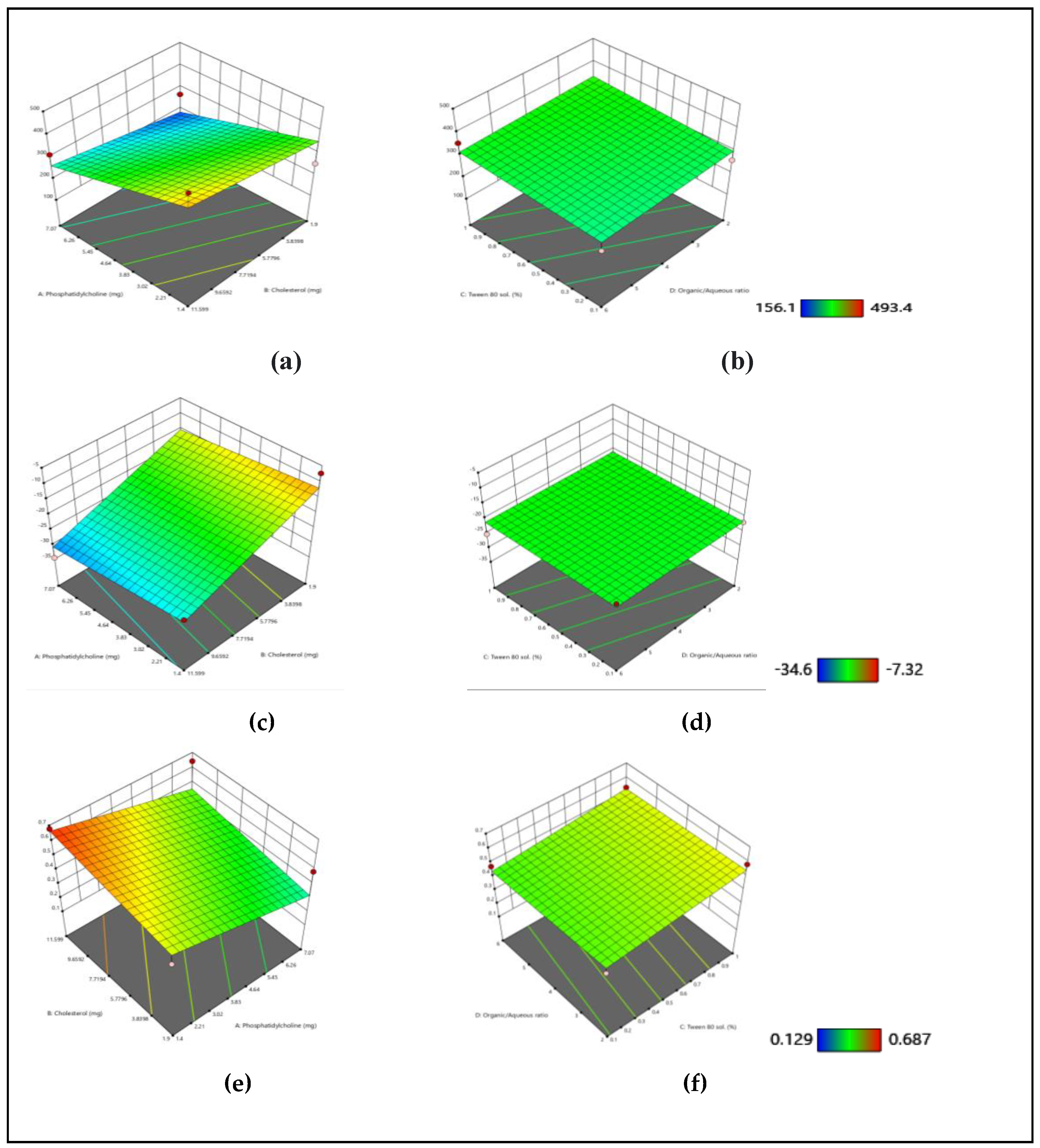
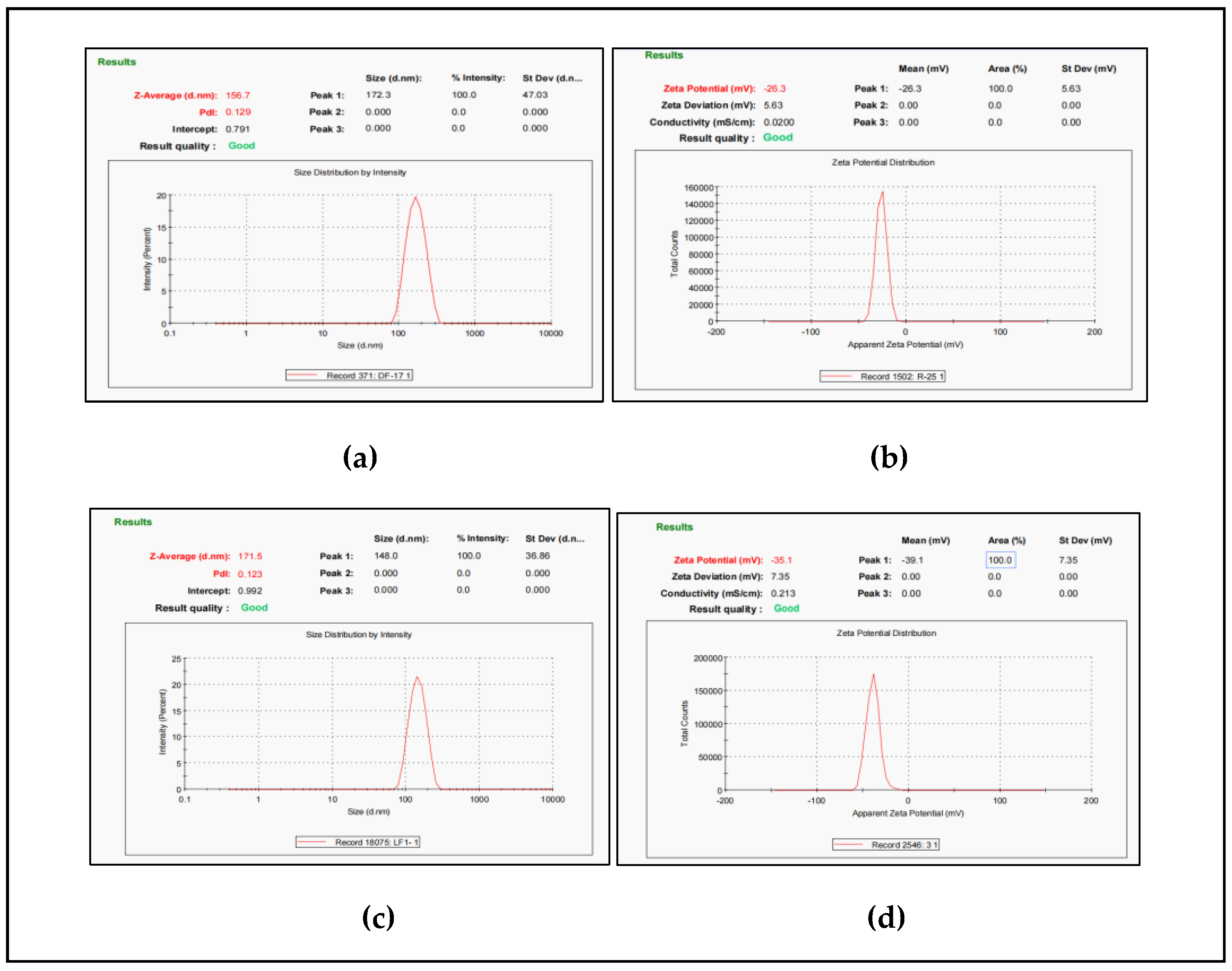
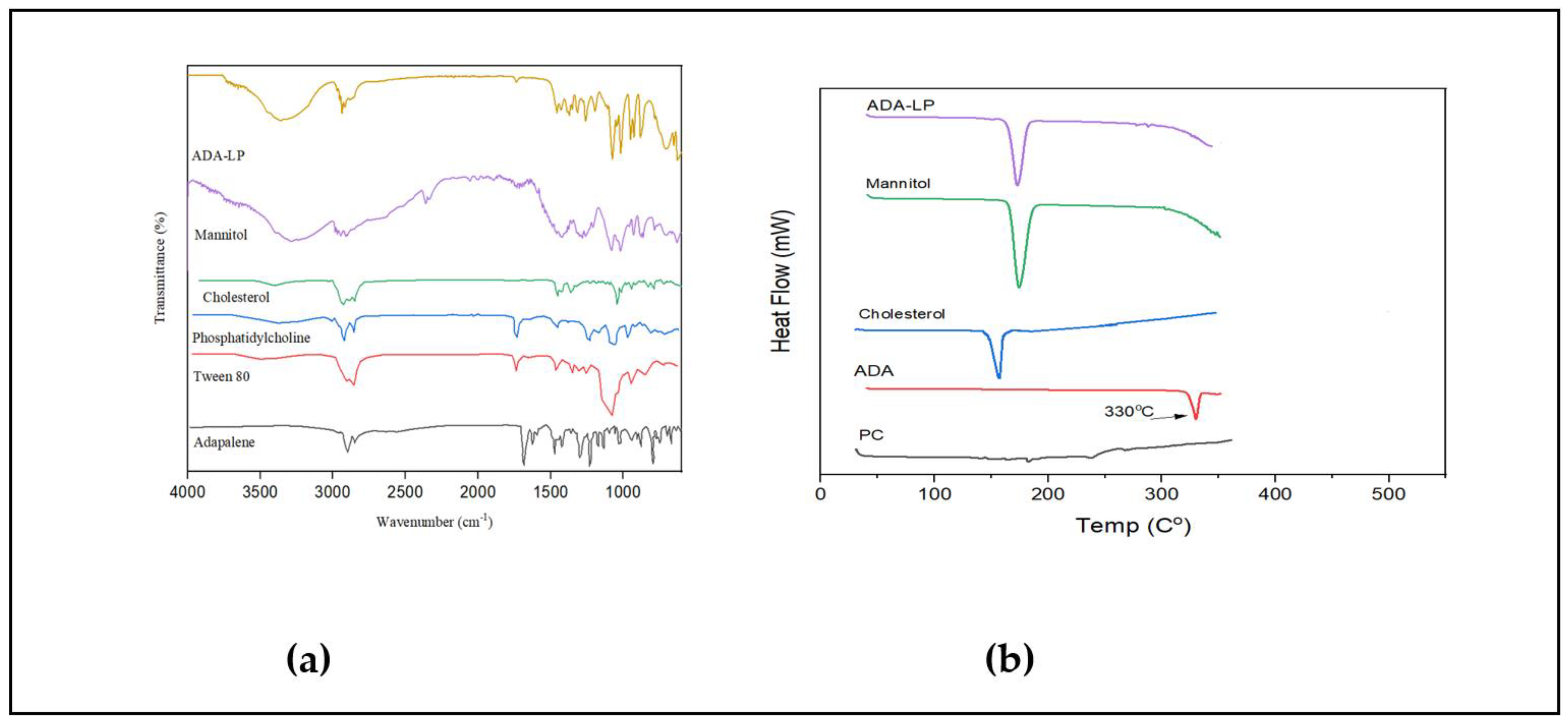
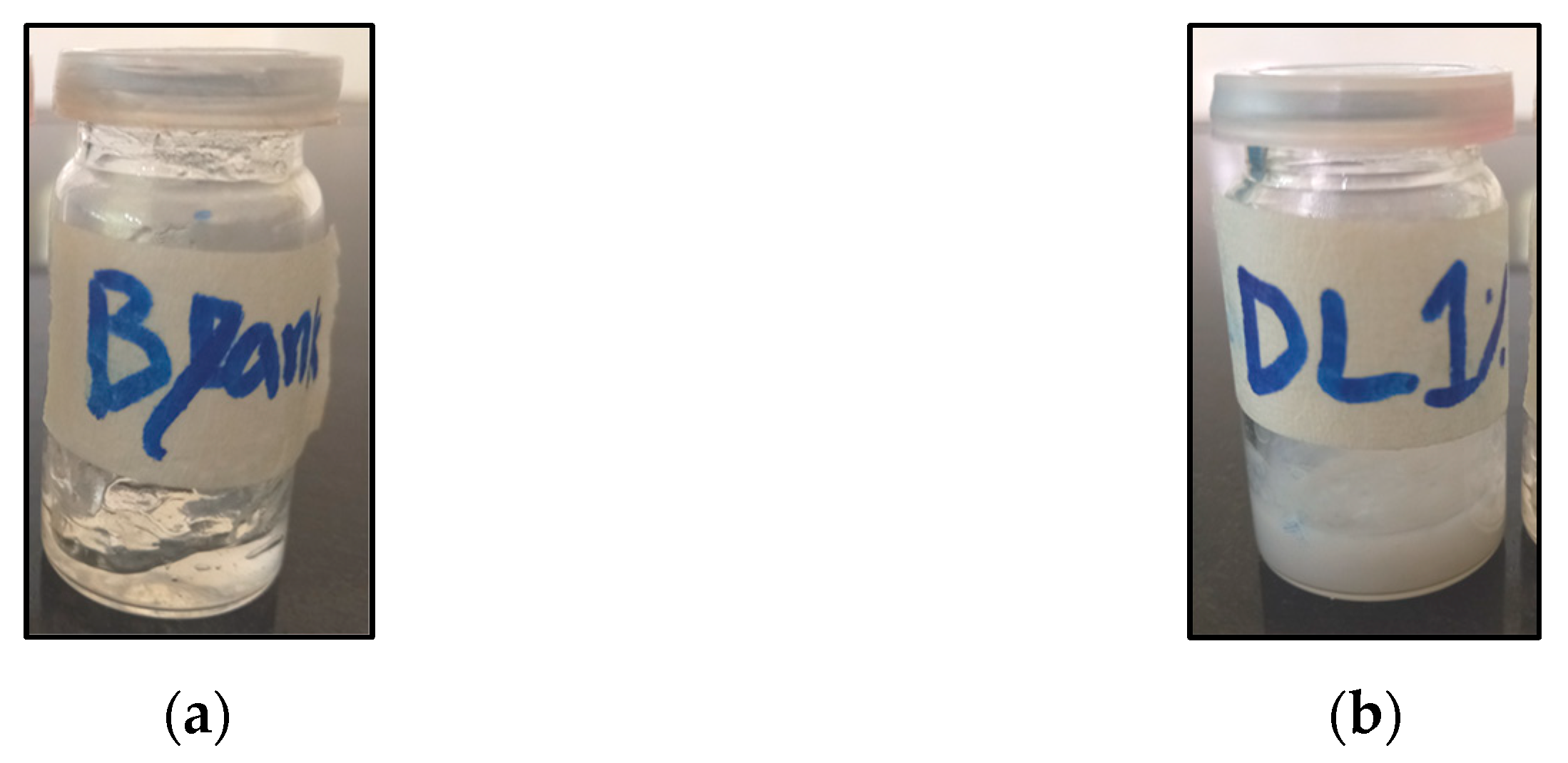
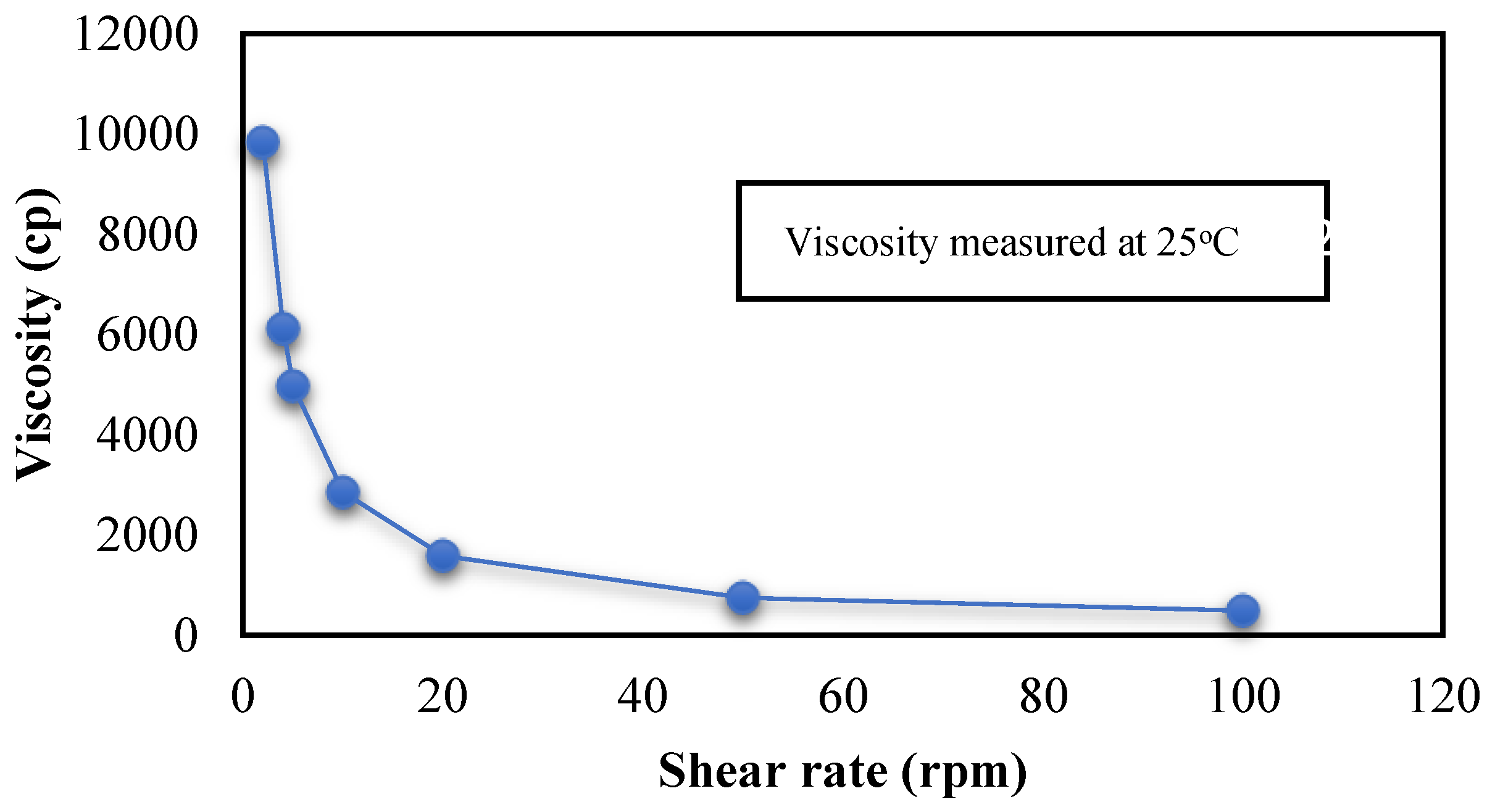
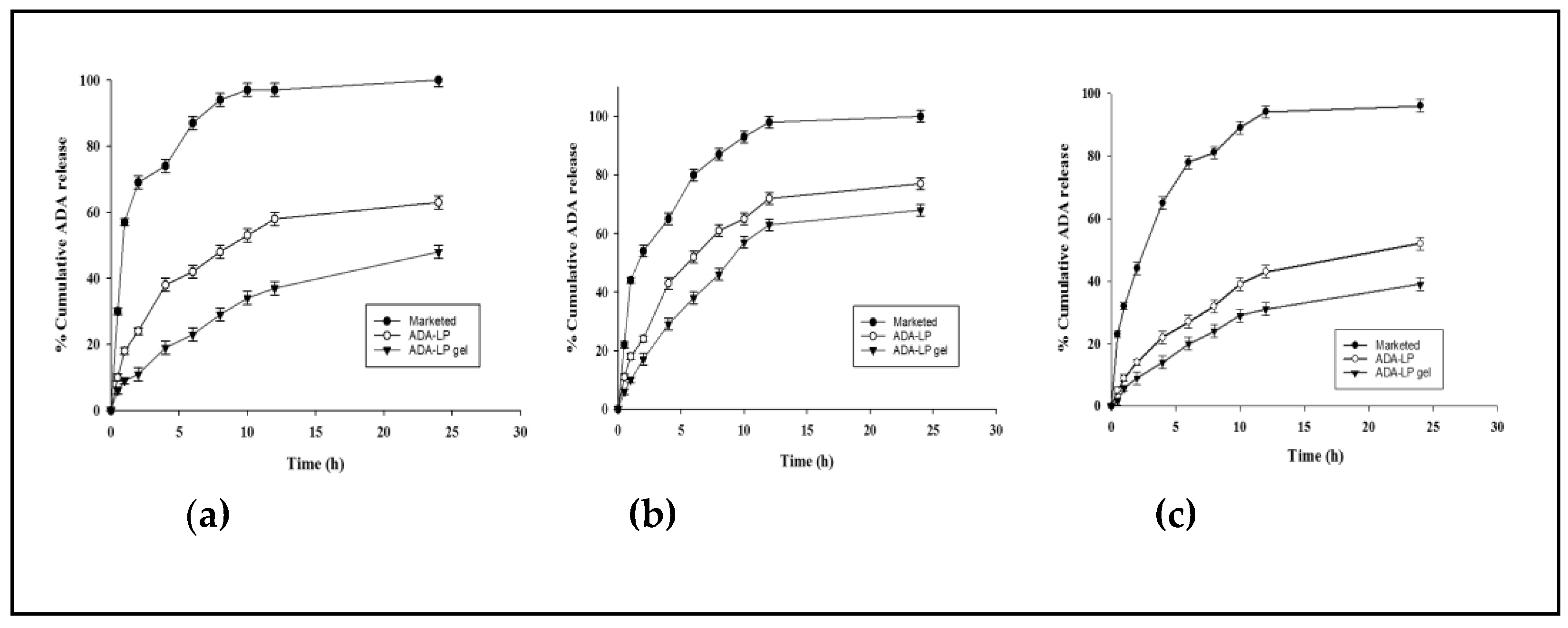
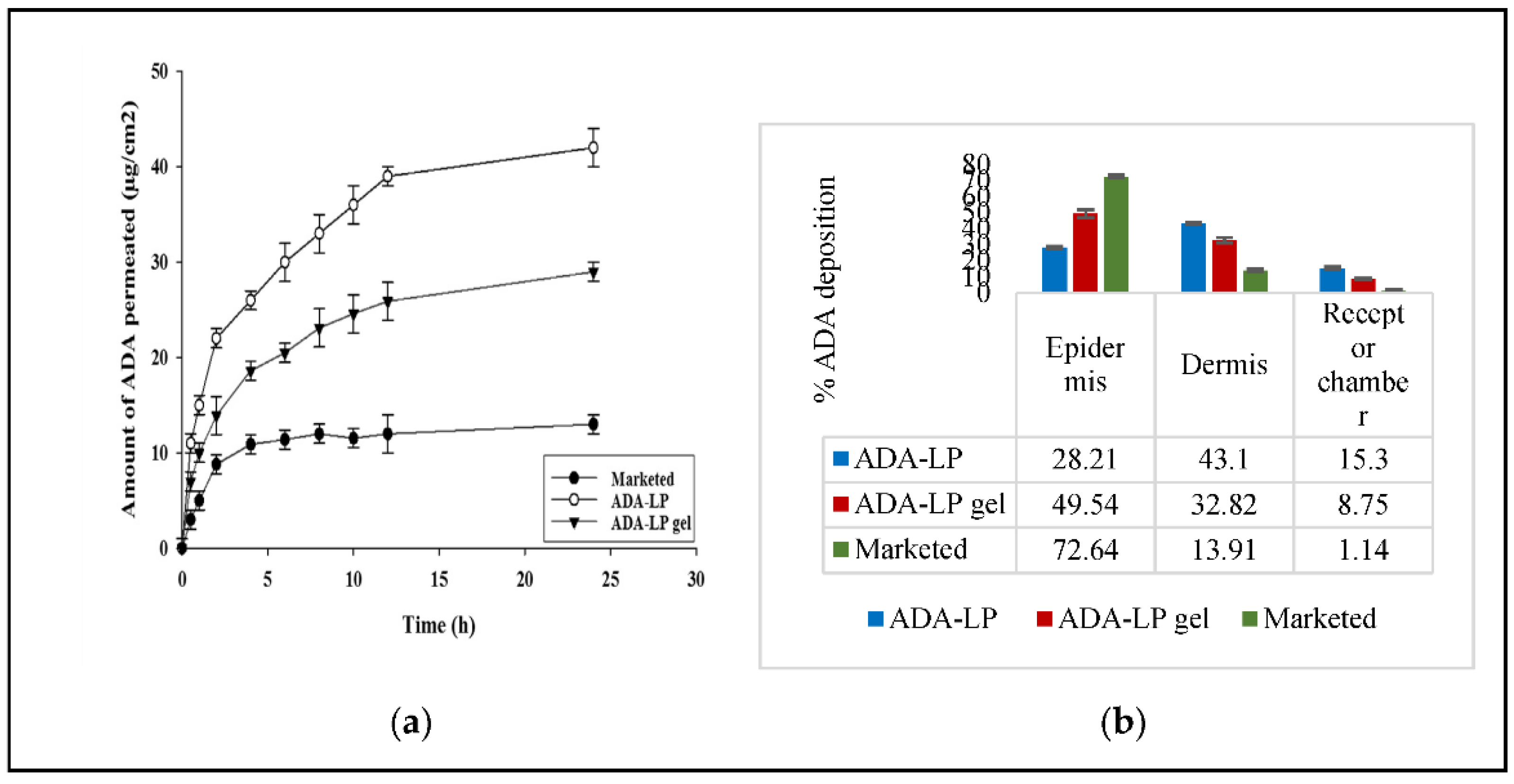
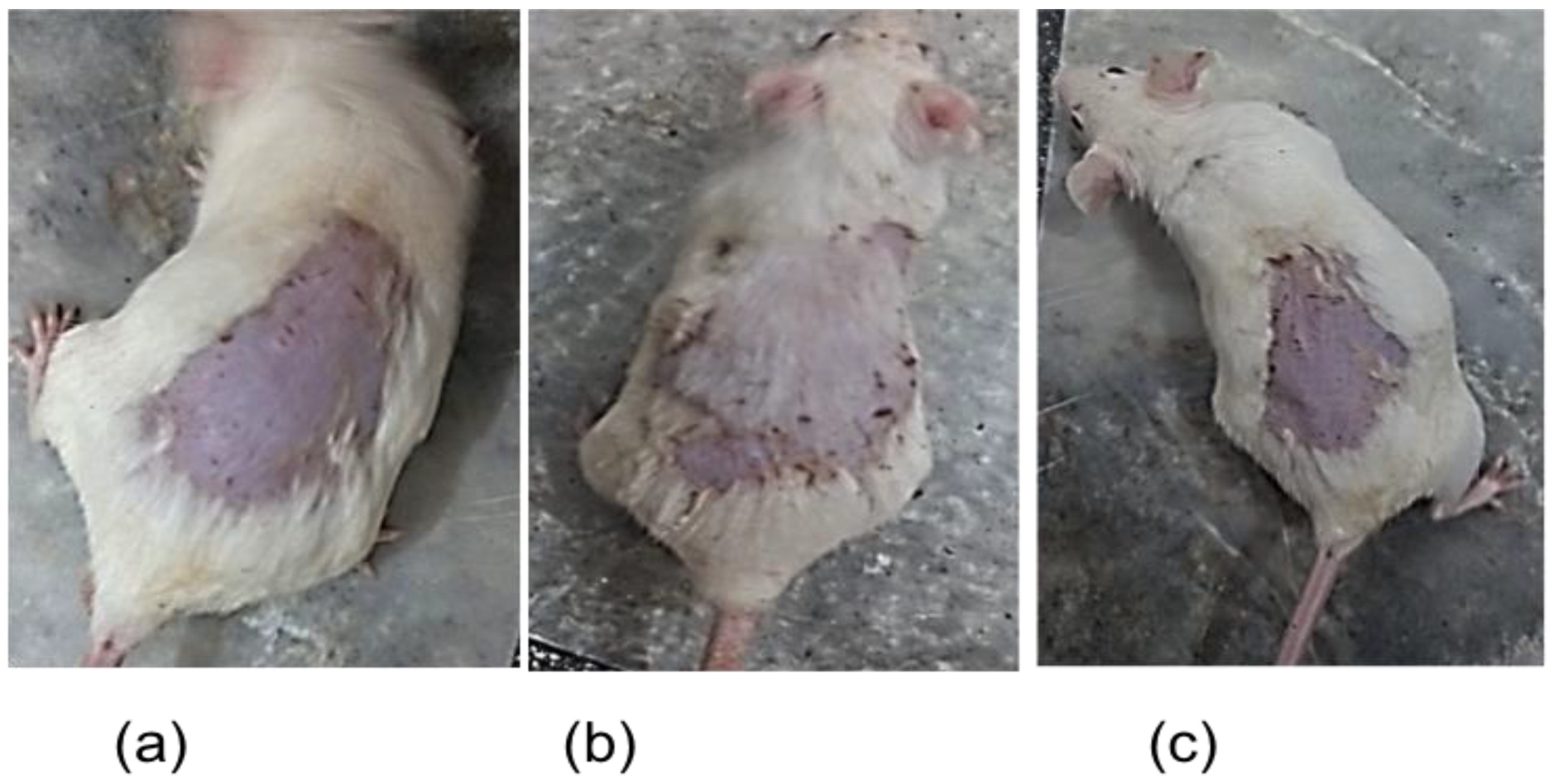

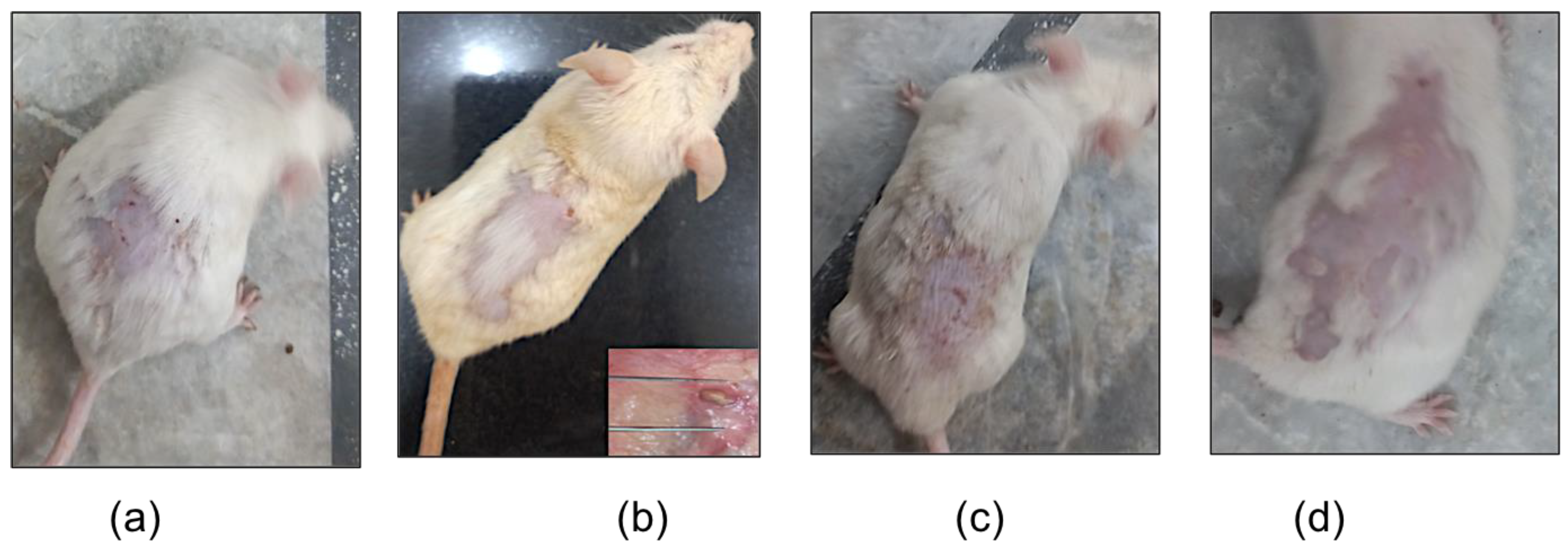

| Design Summary | |||||
|---|---|---|---|---|---|
| File Version | 12.0.3.0 | Subtype | Randomized | ||
| Study Type | Response Surface | Runs | 29 | ||
| Design Model | Quadratic | Blocks | No Blocks | ||
| Build Time (ms) | 19.00 | ||||
| Factor | Name | Units | Type | Minimum | Maximum |
| A | Phosphatidylcholine (PC) | mg | Numeric | 1.40 | 7.07 |
| B | Cholesterol (CH) | mg | Numeric | 1.90 | 11.60 |
| C | Tween 80 solution | % | Numeric | 0.1 | 1.0 |
| D | Organic/aqueous ratio | Numeric | 2.00 | 6.00 | |
| Independent Variable | Dependent Variables | ||||||
|---|---|---|---|---|---|---|---|
| Run | Factor 1: PC (mg) | Factor 2: CH (mg) | Factor 3: Tween 80 Solution (%) | Factor 4: Organic/Aqueous Ratio | Response 1: Size (nm) | Response 2: Zeta Potential (mV) | Response 3: PDI |
| 1 | 7.07 | 1.90 | 0.55 | 1:4 | 267.7 ± 2.4 | −19.0 ± 1.4 | 0.48 ± 0.7 |
| 2 | 7.07 | 11.59 | 0.55 | 1:4 | 313.2 ± 3.6 | −34.6 ± 1.6 | 0.64 ± 1.4 |
| 3 | 7.07 | 6.74 | 0.55 | 1:2 | 280.7 ± 1.2 | −15.2 ± 2.1 | 0.37 ± 1.1 |
| 4 | 4.23 | 11.59 | 0.10 | 1:4 | 396.8 ± 4.3 | −27.0 ± 1.1 | 0.60 ± 1.6 |
| 5 | 4.23 | 11.59 | 0.55 | 1:6 | 273.9 ± 3.2 | −26.3 ± 1.9 | 0.49 ± 1.3 |
| 6 | 7.07 | 6.74 | 0.55 | 1:6 | 282.4 ± 4.7 | −19.9 ± 1.4 | 0.41 ± 2.8 |
| 7 | 4.23 | 1.90 | 0.55 | 1:2 | 296.7 ± 1.7 | −12.1 ± 2.7 | 0.37 ± 2.5 |
| 8 | 4.23 | 6.74 | 0.10 | 1:6 | 241.5 ± 2.5 | −20.6 ± 1.5 | 0.47 ± 1.8 |
| 9 | 1.40 | 1.90 | 0.55 | 1:4 | 251.8 ± 2.8 | −7.32 ± 1.3 | 0.46 ± 1.2 |
| 10 | 4.23 | 6.74 | 0.55 | 1:4 | 280.2 ± 3.2 | −27.0 ± 1.3 | 0.45 ± 1.1 |
| 11 | 4.23 | 6.74 | 0.55 | 1:4 | 277.4 ± 4.5 | −27.0 ± 1.5 | 0.41 ± 1.9 |
| 12 | 4.23 | 6.74 | 1 | 1:2 | 318.3 ± 1.9 | −21.6 ± 1.6 | 0.58 ± 2.7 |
| 13 | 1.40 | 6.74 | 1 | 1:4 | 485.5 ± 2.5 | −18.5 ± 2.3 | 0.68 ± 2.5 |
| 14 | 1.40 | 6.74 | 0.55 | 1:2 | 458.6 ± 4.6 | −24.2 ± 2.4 | 0.67 ± 2.9 |
| 15 | 1.40 | 11.59 | 0.55 | 1:4 | 493.4 ± 2.4 | −26.6 ± 1.9 | 0.67 ± 1.2 |
| 16 | 4.23 | 6.74 | 0.55 | 1:4 | 277.4 ± 2.2 | −27.0 ± 2.4 | 0.41 ± 1.6 |
| 17 | 4.23 | 11.59 | 0.55 | 1:2 | 327.2 ± 1.3 | −26.4 ± 2.6 | 0.64 ± 1.3 |
| 18 | 4.23 | 6.74 | 0.55 | 1:4 | 202.7 ± 5.4 | −21.4 ± 1.5 | 0.31 ± 3.9 |
| 19 | 4.23 | 6.74 | 0.55 | 1:4 | 184.6 ± 2.3 | −27.0 ± 1.7 | 0.45 ± 3.2 |
| 20 | 4.23 | 6.74 | 1 | 1:6 | 355.4 ± 4.4 | −25.1 ± 1.3 | 0.53 ± 1.4 |
| 21 | 1.40 | 6.74 | 0.1 | 1:4 | 434.6 ± 3.3 | −17.4 ± 2.6 | 0.53 ± 1.8 |
| 22 | 7.07 | 6.74 | 0.1 | 1:4 | 156.1 ± 2.6 | −26.3 ± 1.5 | 0.12 ± 1.3 |
| 23 | 4.23 | 1.90 | 0.1 | 1:4 | 298.7 ± 4.6 | −11.3 ± 2.4 | 0.53 ± 2.1 |
| 24 | 1.40 | 6.74 | 0.55 | 1:6 | 432.2 ± 2.9 | −20.4 ± 1.5 | 0.64 ± 3.8 |
| 25 | 4.23 | 11.59 | 1 | 1:4 | 315.8 ± 3.5 | −24.2 ± 1.7 | 0.52 ± 2.4 |
| 26 | 7.07 | 6.74 | 1 | 1:4 | 237.5 ± 3.3 | −19.0 ± 1.1 | 0.40 ± 2.0 |
| 27 | 4.23 | 1.90 | 0.55 | 1:2 | 296.7 ± 2.8 | −12.1 ± 2.3 | 0.37 ± 1.5 |
| 28 | 4.23 | 6.74 | 0.1 | 1:6 | 320.0 ± 2.1 | −23.0 ± 3.5 | 0.45 ± 1.2 |
| 29 | 4.23 | 1.90 | 1 | 1:4 | 240.0 ± 2.5 | −22.0 ± 1,8 | 0.35 ± 1.8 |
| Characterization of Blank and ADA-LP Gel (Mean ± SD, Where n = 3) | ||||
|---|---|---|---|---|
| Dosage Form | Physical Appearance | pH | Spreadability (mm2) | Drug Content (%) |
| Blank gel | Clear | 6.4 ± 0.06 | 309 ± 0.08 | - |
| ADA-LP gel | Opaque | 6.43 ± 0.03 | 255.2 ± 0.4 | 87.083 ± 0.01 |
| Time (h) | Positive Control | Negative Control | Treatment with ADA-LP Gel | |
|---|---|---|---|---|
| Erythema | 1 | 0 | 2 | 0 |
| 12 | 0 | 4 | 0 | |
| 24 | 0 | 4 | 0 | |
| Edema | 1 | 0 | 1 | 0 |
| 12 | 0 | 1 | 0 | |
| 24 | 0 | 1 | 0 |
| 25 ± 2 °C at 60% RH ± 5% RH | 40 ± 2 °C at 75% RH ± 5% RH | |||||||||
|---|---|---|---|---|---|---|---|---|---|---|
| Time (Months) | 0 | 1 | 2 | 3 | 6 | 0 | 1 | 2 | 3 | 6 |
| Size (nm) | 171.5 ± 4.1 | 171.9 ± 2.1 | 173.4 ± 1.7 | 174.7 ± 1.6 | 174.9 ± 3.6 | 171.5 ± 4.1 | 173.9 ± 3.2 | 175.1 ± 2.6 | 176.4 ± 1.5 | 179.8 ± 1.9 |
| Zeta potential (mV) | −35.1 ± 1.5 | −35.6 ± 1.2 | −36.3 ± 2.7 | −36.7 ± 2.1 | −37.1 ± 1.1 | −35.1 ± 2.1 | −36.9 ± 2.7 | −37.9 ± 3.6 | −38.1 ± 2.7 | −39.4 ± 2.3 |
| PDI | 0.123 ± 1.7 | 0.127 ± 2.2 | 0.212 ± 1.5 | 0.214 ± 2.3 | 0.217 ± 1.3 | 0.123 ± 1.7 | 0.195 ± 1.5 | 0.236 ± 1.3 | 0.233 ± 2.7 | 0.243 ± 1.5 |
| EE% | 89.69 ± 0.5 | 88.20 ± 0.4 | 86.12 ± 0.3 | 86.91 ± 0.1 | 85.71 ± 0.1 | 89.69 ± 0.5 | 87.31 ± 0.7 | 84.06 ± 0.1 | 84.63 ± 0.9 | 83.19 ± 0.2 |
Disclaimer/Publisher’s Note: The statements, opinions and data contained in all publications are solely those of the individual author(s) and contributor(s) and not of MDPI and/or the editor(s). MDPI and/or the editor(s) disclaim responsibility for any injury to people or property resulting from any ideas, methods, instructions or products referred to in the content. |
© 2023 by the authors. Licensee MDPI, Basel, Switzerland. This article is an open access article distributed under the terms and conditions of the Creative Commons Attribution (CC BY) license (https://creativecommons.org/licenses/by/4.0/).
Share and Cite
Arooj, A.; Rehman, A.U.; Iqbal, M.; Naz, I.; Alhodaib, A.; Ahmed, N. Development of Adapalene Loaded Liposome Based Gel for Acne. Gels 2023, 9, 135. https://doi.org/10.3390/gels9020135
Arooj A, Rehman AU, Iqbal M, Naz I, Alhodaib A, Ahmed N. Development of Adapalene Loaded Liposome Based Gel for Acne. Gels. 2023; 9(2):135. https://doi.org/10.3390/gels9020135
Chicago/Turabian StyleArooj, Asma, Asim Ur Rehman, Muhammad Iqbal, Iffat Naz, Aiyeshah Alhodaib, and Naveed Ahmed. 2023. "Development of Adapalene Loaded Liposome Based Gel for Acne" Gels 9, no. 2: 135. https://doi.org/10.3390/gels9020135
APA StyleArooj, A., Rehman, A. U., Iqbal, M., Naz, I., Alhodaib, A., & Ahmed, N. (2023). Development of Adapalene Loaded Liposome Based Gel for Acne. Gels, 9(2), 135. https://doi.org/10.3390/gels9020135








